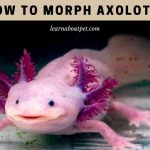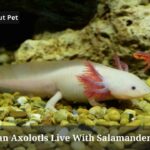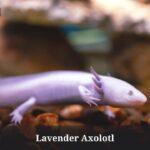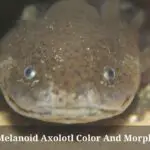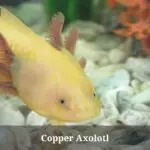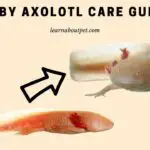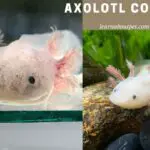Axolotls are genetically related to salamanders. Although classified as amphibians, they have adapted to water and spend all their life in water. For this reason, people mistakenly think it is a fish. Considered nearly extinct and is only bred in captivity for lab work and as a pet.
Axolotls are “neotenic” species and don’t morph naturally. Neotenic comes from Latin and means to reach sexual maturity while still retaining the qualities of a larva.
In this post, we discuss the axolotl morphs, axolotl transformation, their reasons, and related topics. Continue reading on if you are interested to know more about axolotl morphing.
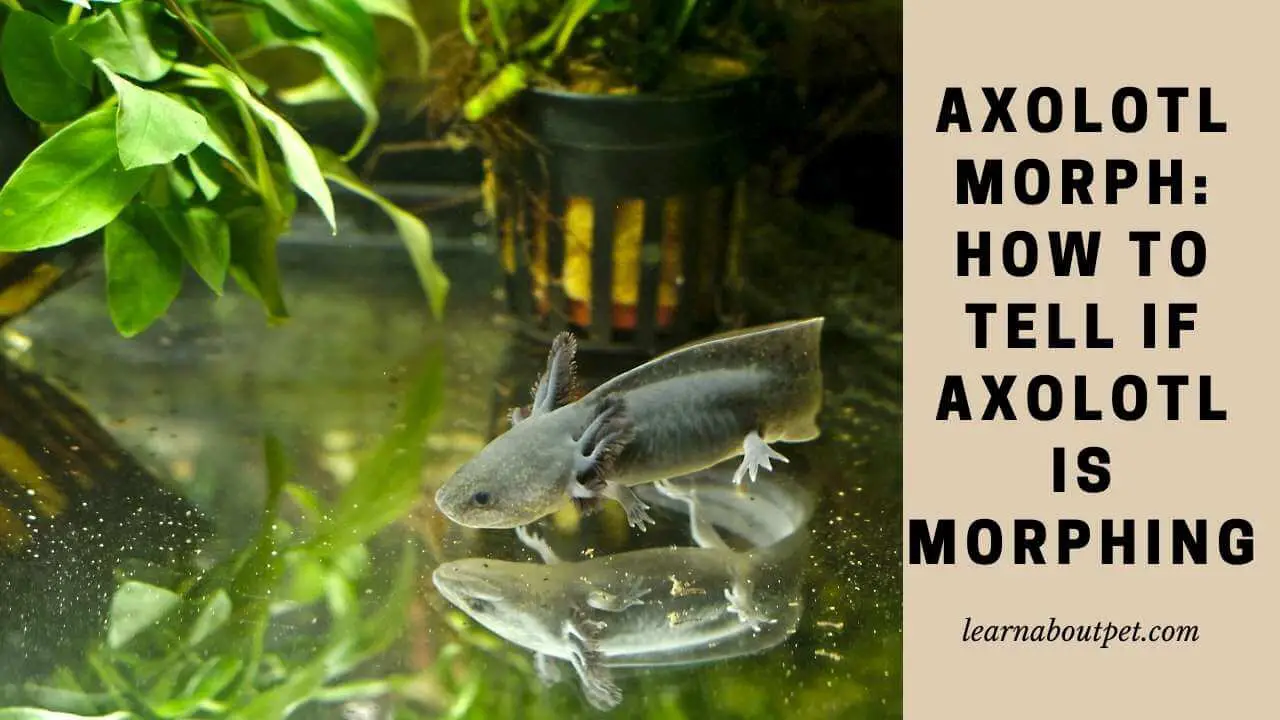
Hope you enjoy the write-up. Do write to us if you have queries, we will try to help with your queries.
Are Axolotls Supposed To Morph?
Because of the research work being done on the axolotls in laboratories and the interest shown by enthusiasts, people are curious and ask can axolotl morph?
Metamorphosis is a natural process in certain species, especially insects, where they change physically during their growth stage.
Scientists have classified metamorphism into four stages namely egg stage, larva stage, pupa, and then adult stage.
In the case of the salamanders (ancestors of axolotls), and the axolotls themselves, the metamorphosis stages are egg, larva, juvenile, and adult. Salamanders morphed and developed proper lungs to live on land.
By nature, axolotl morph does not happen. During adulthood, they do develop rudimentary lungs but only use their gills to breathe underwater. Only sometimes they will surface to gulp in the air.
It is very rare if an axolotl morphs. In nature, this could be triggered because of some external factors, especially due to the production of thyroxin.
What Causes Axolotl To Morph?
The metamorphism in axolotls is a hormonal change triggered by an excess of iodine in their body. Iodine stimulates the thyroid gland to produce thyroxin, which activates the morphing process.
Axolotl morph has happened by the presence of an excess of iodine in the axolotl’s tank water or food. Alternatively, by injecting a thyroid hormone in controlled laboratory experiments an axolotl morph has been attained.
Is It Bad For An Axolotl To Morph?
Depending at what age the morphing starts, an axolotl morph actually shortens the axolotl’s life span considerably and also reduces the reproduction rate.
It must be remembered that once the morphing starts it cannot be reversed. You must help your axolotl to completely morph into a salamander.
Once the axolotl morphs, it will lose its gills and fins and won’t be able to swim and live underwater. It will need land to live on. A new habitat. Besides the environment, its food requirements will change.
How Do I Know If My Axolotl Is Morphing?
An axolotl morph would normally take a month or so to compete, depending at what stage, juvenile or adult, it started. There are many signs to observe. Some are physical and others are behavioral.
As the axolotl morphs, it is important that the caregiver watch out for physical changes in its body. The same are shared below.
- Disappearing dorsal fin. The fin will start decreasing in size until it vanishes completely.
- Receding gills. They will start diminishing and ultimately be gone.
- Receding tail fin. The tail fin starts to grow smaller and ultimately disappears.
- Bulging eyes. The eyes bulge out prominently.
- Eyelids. Besides bulging, one can see eyelids being formed.
- Thicker legs. The legs and arms start to get thicker, which is required for walking on land.
- Less webbed feet. The paws and feet will be less webbed and the fingers and toes will become thicker, prominent, and less connected.
- Color changes. The body’s skin color changes, either lightening or darkening.
- Difficulty in swimming. Because of the receding fins, the axolotl will have difficulty in swimming and reaching the surface of the water to gulp air.
Some other changes observed behaviorally when axolotl morphs, are as follows.
- One major change to be noted is its desire to get out of the water. It will try to keep its snout out of water. This will be close to the final stages of the transformation.
- It will be eating less, as it is stressed.
The axolotl morph action produces great stress during this changeover from an aquatic to an amphibian animal.
If proper care is not provided to the axolotl during this transformation, it can be fatal for it.
Consulting a specialist veterinary, having good experience in treating axolotls is important, as just a small misunderstanding can kill the axolotl.
How Can I Help A Axolotl Morphing Or Transforming?
It is very important to first recognize if it is an axolotl morph transformation going on. Second, take special care and help the axolotl morph transform into a salamander.
The first thing is to be sure your axolotl is going through an axolotl morph change and it is not any other condition it is reacting to.
Consult your friends and other pet owners and enthusiasts via blogs and forums and vets specializing in such animals and having experience with axolotls.
Outlined below are some ways you as a caregiver can help your axolotl morph safely into a salamander to live out of water.
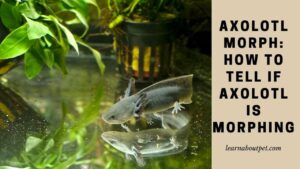
Awareness
The caregiver must recognize the changes going on in the body and the behavior of the axolotl. The clear signs of an axolotl morph happening are
- The dorsal and tail fins are receding
- The eyes are bulging and developing eyelids
- The external gills are getting smaller and receding
- Color changes of the skin, getting lighter or darker
- Legs and arms are getting thicker
- The axolotl swims to the water surface and likes to keep its snout out of water
- Change in feeding habits
The axolotl is under great stress during this period, if a proper environment is not provided to help complete its morph, there are great chances it will die. By timely actions, it is possible to get a healthy and robust axolotl transformed.
The first thing to know and act is that a morphed axolotl is not an aquatic animal anymore. It is a salamander, which is a land animal that likes water.
Changes in habitat
During the final stages of transformation, the axolotl will start breathing air from its snout and will come to the water surface often.
Make the water shallow enough where it just covers its body and the axolotl can easily breathe air from above the water surface.
To assist the axolotl in this, make the tank water shallow and put some island sort of thing or slope, where it can easily climb and rest to come out of water. If not done, there is all the likelihood of the axolotl being drowned.
Some owners suggest tilting the tank a little bit. With shallow water, the axolotl will find a place where it can easily take its snout out of the water to breathe.
At some time the transformed axolotl would like to come out of the water completely. Make sure such a place is provided in the tank.
At this point, some hides, rocks, etc. can be arranged so the axolotl feels safe and relaxed in its new environment.
Better have a breathable cover or top on the axolotl’s tank, as there is a tendency for the transformed axolotls to climb out of their tanks.
Observe changed life
Once the axolotl morph transformation is completed, it will be observed that the morphed axolotl does not live in water all time.
There is not much information available for the morphed axolotls as these are rare cases. The water can be removed altogether and replaced by substrate or wet paper towels.
Keep its environment clean and simple all time, so they remain healthy. It must feel safe and stress-free in the hides and other decorations provided.
Observe closely for at least a fortnight to rule out any unknown effects. Do consult a vet with experience of axolotls to be sure nothing has been missed out.
Enclosure adjustments
The morphed axolotl will need water to keep itself hydrated. Like salamanders they absorb water through their skin, so provide a shallow water dish for it to soak in and hydrate itself occasionally when it feels so.
This is besides providing the moist substrate of wet paper towels or other appropriate commercially available soil all time. The substrate pieces should not be so small for the transformed axolotl to swallow.
A word of caution, all water used, even for wetting the paper towels, must be treated and chlorine-free. Do not use tap water directly.
Adjust the temperature range of the tank between 65°F and 72°F (18°C – 22°C ) all time. It is observed temperatures above 78°F (25°C) for extended periods are fatal for the morphed axolotl.
New food introduction
Introduce your morphed axolotl to the live food gradually. A stressed axolotl may refuse food initially and will have lost weight during the transformation.
Following is a suggested list of live insects and worms which can be fed to the morphed axolotl.
- Earthworms. Assure they are small bite-size.
- Mealworms. These should be without their hard shell, which is when freshly shed.
- Slugs
- Crickets. Assure they are small to medium size, which the axolotl can easily gulp. The axolotl can become afraid of a large size cricket.
- Waxworms. These are high in fat and will help gain weight of the starved axolotl
It is important to clear and clean all unconsumed insects and worms from the enclosure after feed time, as the live crickets can bite the axolotl and be a source of stress for it.
How To Get Axolotl Morphs For Sale?
Besides the term axolotl morph meaning physical changing of the axolotl from an aquatic to land-based species called the metamorphosis, the term morph is also used for the different colored varieties of axolotls for sale.
It is only the color changes brought about by breeding different colored axolotls, to get a prominent color from one of the parent axolotls.
This is only combining the genes from the parents to give one prominent color. Genetically the axolotls are the same, only having the color of one of their parents.
There are many helpful forums and breeders exclusively dedicated to axolotls. Different shows and exhibitions are held where axolotls are sold. One such place is axolotl morphs reddit.
Then there are the laboratories doing research that have surplus axolotls. With the right connections, one can get an axolotl from there which would be medically certified.
There are many pet owners who would sell their bred axolotls. But in this case, one cannot be sure of diseases or other health conditions of the for sale axolotls.
Different Axolotl Morphs
Here the term axolotl morph means the different color types of axolotls developed by the breeders and enthusiasts by mating different colored and varieties of axolotls.
This is all a commercial game. It is not easy to get one particular color in an offspring.
It is just a case of matching the right type of chromosomes from each parent to get the desired color in the offspring. It is only after many tries one gets the desired results.
Because of the demand from customers and pet lovers, this is a big business. There are claims of developing over 15 types of axolotl morphs with different colors.
To attract customers, all types of catchy and exotic names are used like Wild Type Axolotl, Leucistic, White Albino, Golden Albino, Melanoid / Black, and many more.
Prices can go into thousands of dollars. The rarer a color is the higher is the price.
Final Verdict On Axolotl Morph
The term axolotl morph in a technical sense here is used for the metamorphosis of the axolotl from its aquatic stage (breathing through gills) to a salamander stage which is purely land-based (breathing through lungs).

It rarely happens spontaneously with axolotls, especially in captivity. Make sure to choose their tank mates wisely.
However, this condition can be induced by changing the diet or the habitat water quality with the controlled introduction of iodine, which affects the thyroid function of the axolotl.
However this change is very stressful for the axolotl and if a proper environment (in captivity) is not provided, it can be fatal for the axolotl.
The other common use of the term axolotl morph is for the availability of different colored axolotls developed by the breeders and pet enthusiasts on demand of the customers.
These command different prices and can fetch anywhere from a few hundred to thousands of dollars, depending on the rarity.

Welcome to Learn About Pet. My name is Rajkumar Ravichandran and I love all pets, travel, and amazing food. I write about my passion and personal experience caring for multiple pets in this blog! ❤️
Post Disclaimer
DISCLAIMER: THIS BLOG OR WEBSITE, "Learn About Pet", DOES NOT PROVIDE YOU WITH MEDICAL ADVICE AND IS NOT A SUBSTITUTE FOR MEDICAL ADVICE. ALWAYS GET IN TOUCH WITH YOUR PERSONAL VETERINARIAN AND USE INFORMATION HERE AS GENERAL ADVICE.
The information, including but not limited to, text, graphics, images and other material contained on this website are for informational purposes only. No material on this site is intended to be a substitute for professional veterinary advice, food recommendation, diagnosis, or treatment. Always seek the advice of your veterinarian or other qualified health care provider with any questions you may have regarding a medical condition or for pet food related questions.
